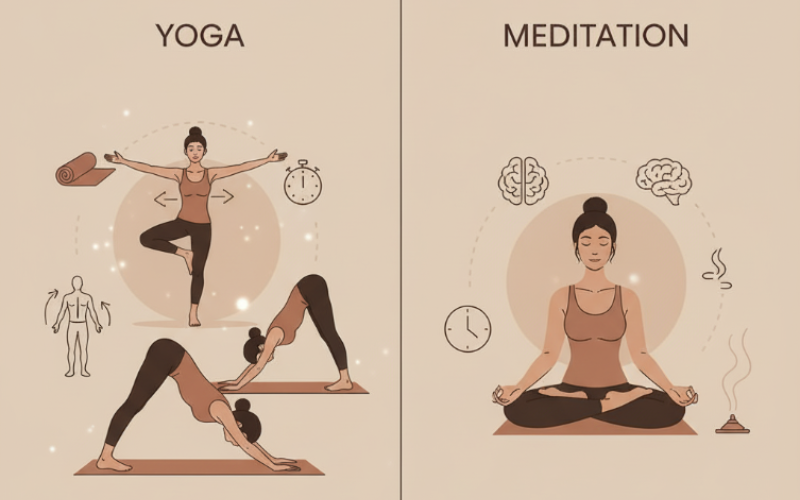7 Key Differences Between Yoga and Meditation You Must Know
•Posted on September 28 2025

Introduction
If you’ve ever thought yoga and meditation are the same, you’re not alone. Both are ancient practices rooted in mindfulness and self-awareness, but they serve very different purposes. Yoga often looks like stretching or exercise, while meditation might appear to be just sitting quietly. Yet, the reality goes much deeper.
Understanding the differences between yoga and meditation can help you choose the right practice for your needs—whether you want to improve your physical health, calm your mind, or create a balanced lifestyle. Let’s break this down in a simple, practical way so you know exactly how each one can support your journey toward holistic well-being.
What is Yoga?

A Physical and Spiritual Practice
Yoga is far more than bending your body into poses. At its core, it’s a discipline that unites movement, breath, and awareness. When you flow through postures, you’re not just stretching your muscles—you’re also training your mind to stay present.
There are different styles to explore:
-
Hatha Yoga for beginners, focusing on gentle postures and breathing.
-
Vinyasa Yoga for those who enjoy a faster, flow-based practice.
-
Ashtanga Yoga if you want structure and discipline.
There are various types of yoga, each offering a unique way to connect your body and mind while building strength and flexibility. The benefits of yoga go beyond physical fitness — it improves posture, balance, and energy levels, reduces stress, enhances focus, and promotes emotional well-being, making it a holistic path to better health and inner peace.
Purpose of Practicing Yoga
When you step onto the mat, yoga supports you in multiple ways. You build flexibility, strengthen muscles, and improve posture. Beyond the physical, it’s a tool for stress relief and spiritual growth. Think of it as a moving meditation—your body becomes the gateway to mental calm and inner balance.
What is Meditation?

The Art of Inner Stillness
Meditation is all about training your mind to focus and letting go of distractions. Instead of moving your body, you’re working with awareness, breath, or a specific point of focus.
Different types of meditation include:
-
Mindfulness Meditation – observing your thoughts without judgment.
-
Transcendental Meditation – repeating a mantra to reach deeper awareness.
-
Guided Meditation – listening to a teacher or recording that leads your practice.
Each style helps you slow down and cultivate a sense of inner stillness.
Purpose of Practicing Meditation
The benefits of meditation become apparent quickly, even in brief sessions. It helps reduce stress and anxiety, improves mental clarity, and builds emotional resilience. With consistent practice, you gain deeper self-awareness and learn to respond calmly to challenges instead of reacting impulsively.
7 Key Differences Between Yoga and Meditation

1. Physical Movement vs. Mental Stillness
Yoga uses the body as its entry point—poses, stretches, and breathwork. Meditation, on the other hand, asks you to sit still, let your body relax, and shift attention inward.
2. Primary Goal
Yoga’s goal is to balance physical fitness with spiritual awareness. Meditation’s primary goal is mental clarity and inner peace. Both lead to mindfulness, but they take different paths.
3. Tools and Techniques
Yoga requires tools like a mat, comfortable space, and specific postures. Meditation is simpler—you only need a quiet spot, your breath, or a mantra.
4. Time and Effort Required
A yoga session often lasts 30–60 minutes, making it a more structured routine. Meditation can be as short as 5–10 minutes, making it easier to fit into a busy schedule.
5. Body vs. Mind Emphasis
Yoga strengthens the body-mind connection, using movement to influence your mental state. Meditation focuses primarily on the mind, training it to stay centered and calm.
6. Origins Within Ancient Philosophy
Yoga is one of the eight limbs in Patanjali’s Yoga Sutras, which combine ethical living, breathwork, and meditation itself. Meditation, however, is a universal practice seen across Hinduism, Buddhism, and even modern mindfulness teachings.
7. Tangible Benefits
Yoga improves flexibility, stamina, and posture. Meditation sharpens focus, lowers anxiety, and helps regulate emotions. Both improve overall wellness but deliver results in different areas.
Can Yoga and Meditation Be Practiced Together?

Complementary Practices
You don’t have to choose between yoga and meditation. In fact, they complement each other beautifully. A yoga session warms up your body and relaxes your nervous system, making it easier to slip into meditation afterward. Together, they create a holistic practice—yoga for physical strength and mobility, meditation for mental clarity and peace. Practicing both allows you to experience wellness on every level.
Which One Should You Start With?

Your choice depends on what you need most right now.
-
If you’re seeking better physical health, start with yoga.
-
If your priority is reducing stress and finding focus, meditation may be the best entry point.
-
If you want a balanced lifestyle, combining both is ideal. Begin with 10 minutes of yoga followed by 5 minutes of meditation and gradually expand your routine.
Conclusion
Yoga and meditation often overlap, but they aren’t the same. Yoga engages your body through mindful movement, while meditation quiets your mind through focused stillness. Both share the goal of improving your well-being, but work through different methods.If you want physical strength and flexibility, yoga is your path. If you’re after inner calm and emotional balance, meditation will serve you well. And if you want the best of both worlds, blend the two. Start small, stay consistent, and you’ll discover how yoga and meditation together can reshape not only your health but also the way you experience life.
So, roll out your mat or find a quiet corner, take a deep breath, and begin—because your journey to balance starts with just one mindful step
Comments
0 Comments
Leave a Comment